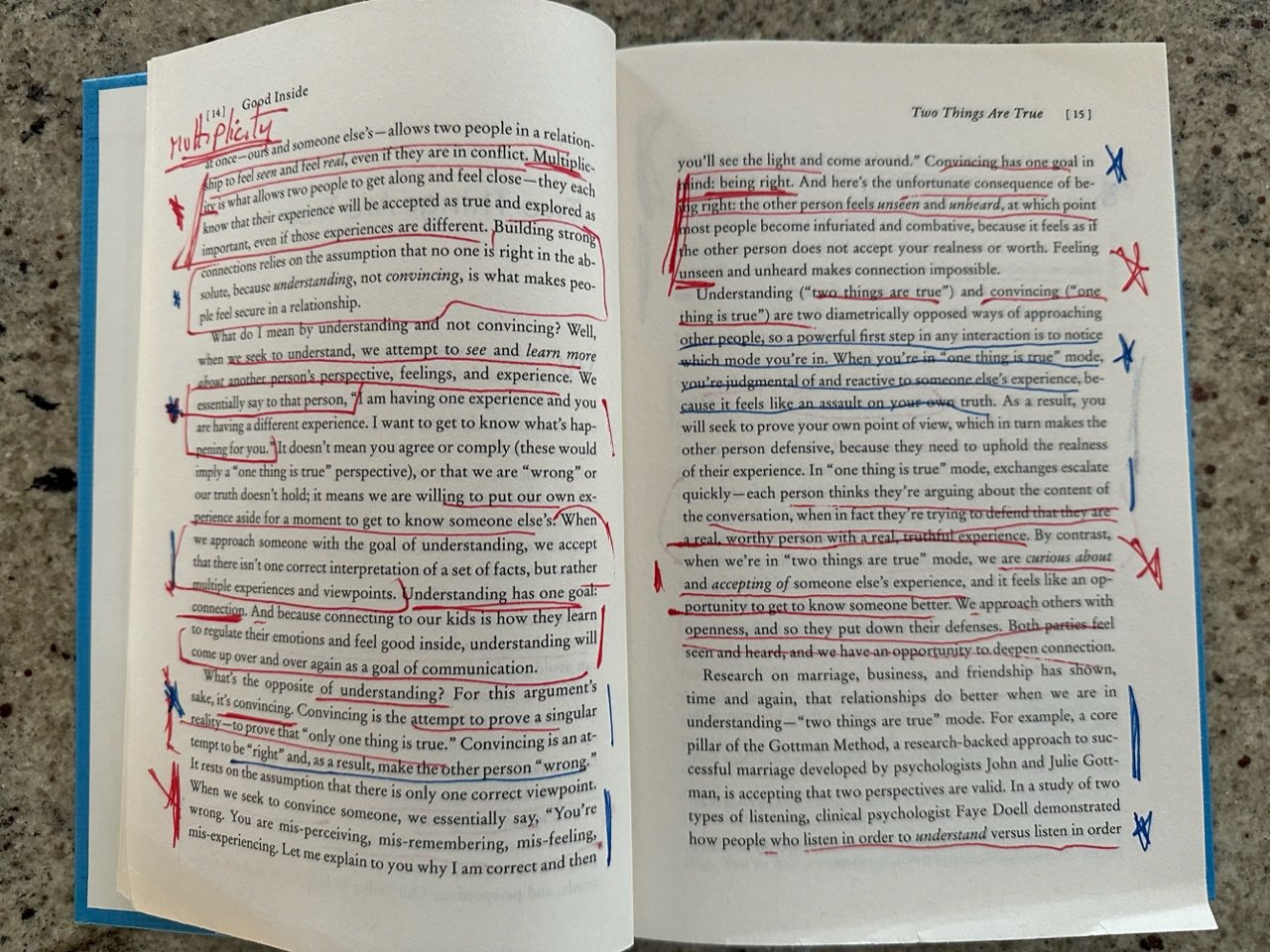The Best Relationship Advice Ever
The most helpful and transformative relationship advice I’ve ever received came from Dr. Becky Kennedy, the clinical psychologist and parenting expert who I’ve written about twice before in “Embracing Your Inner Child” and “The Pitfalls of Praise.” It’s a principle she calls “multiplicity” or “two things are true” mentality, which means being open to two or more seemingly oppositional realities being true at the same time.
“Multiplicity—the ability to accept multiple realities at once—is critical to healthy relationships,” writes Dr. Becky in her best-selling book, Good Inside. “When there are two people in a room, there are also two sets of feelings, thoughts, needs and perspectives. Our ability to hold onto multiple truths at once—ours and someone else’s—allows two people in a relationship to feel seen and feel real, even if they are in conflict.”
Multiplicity fosters connection and trust between people because each person knows that their personal experience will be acknowledged, accepted and explored, even when those experiences differ greatly from one another. “Building strong connections relies on the assumption that no one is right in the absolute, because understanding, not convincing, is what makes people feel secure in a relationship.”
Because convincing is an attempt to prove a singular reality—that “only one thing is true”—Dr. Becky writes, “When we seek to convince someone, we essentially say, ‘You’re wrong. You are mis-perceiving, mis-remembering, mis-feeling, mis-experiencing. Let me explain to you why I am correct and then you’ll see the light and come around.’ Convincing has one goal in mind: being right.”
Two of Myra’s many marked up pages of Good Inside
This type of convincing usually escalates conflict by fueling anger, frustration and combativeness, while undermining trust. This is why Dr. Becky encourages people to become aware of which mode they are in as soon as possible: understanding (“two things are true” mode), or convincing (“only one thing is true” mode). In “two things are true” mode, we bring curiosity about the other person’s experience, as well as acceptance that their reality is true for them, which allows for both empathy and connection.
Prioritizing understanding over convincing does not mean that we have to agree with the other person’s interpretation of the facts, but it does often mean tolerating uncomfortable feelings like anger, pain and disappointment in both ourselves and the other person. Dr. Becky views this as good news, because learning to feel and process uncomfortable emotions without trying to escape them as quickly as possible is essential to building long-term emotional resilience.
The principle of multiplicity also helps us better understand and accept our internal emotional landscape, because all of us regularly experience contradictory emotions and impulses. Whether it’s feeling scared and excited at the same time, or wanting to both hit and hug a loved one when we’re upset, Dr. Becky says that we are our healthiest selves when we’re able to locate our inner observer amid a sea of diverse emotions. “Our ability to experience many seemingly oppositional thoughts and feelings at once—to know that you can experience several truths simultaneously—is key to our mental health,” she writes.
Multiplicity in Action with My Mother
Last month on Mother’s Day, I felt exceedingly grateful to Dr. Becky during a very triggering conflict with my 94-year-old mother. Wanting to make that day extra-special, I planned on visiting my mom twice at her assisted living home. After showing up in the morning with flowers and a gift, I said goodbye, telling her I’d visit again later that afternoon with my husband and kids.
When the four of us arrived at 4:00 PM, my mother looked awful. “WHERE HAVE YOU BEEN?” she yelled with fury when I walked into her room. “ARE YOU TRYING TO KILL ME?” Apparently, when I’d left many hours before, she thought I’d said that I was coming right back, so she’d been in a state of terror for the entire time, sure that something terrible had happened to me.
I tried to calm her down and convince her that she’d misunderstood and shouldn’t be angry with me, but all my attempts failed. Then, finally remembering Dr. Becky’s advice, I took a deep breath, gathered myself as best I could, and moved into “two things are true” mode.
“Wow mom,” I said. “It looks like two very different things are true at the same time. You thought something was terribly wrong and spent many hours worrying. I can see how that made you extremely upset, and I’m very sorry you went through that. My story is totally different. I thought I was being a really good daughter by visiting twice. I thought I’d made the timing clear, so I feel unfairly attacked, and very sad and shaken up by your fury.”
My mother got very quiet and looked at me with surprise as well as a little suspicion. Although it took her a while to calm down (and it took me even longer), that shift into understanding instead of convincing mode doused the fire of her temper and derailed the escalating argument. We were both allowed to have our very different truths, and one didn’t need to cancel the other one out.
Myra’s son Jeff and mother Edith, May 2023
What amazed me that afternoon was how applying the concept of multiplicity upped my awareness of many habitual patterns that were formed when I was very young, and then cemented throughout my entire life. When my mother and I were both allowed to have our big feelings, instead of all my efforts going toward defending myself, I became acutely aware of my inner child’s desperate need to prove that I am a “good girl,” worthy of my mother’s love and approval. I could see how terrified I am to be rejected as a “bad girl,” and how terribly hard it is for me to be the recipient of my mother’s anger (or anyone else’s)—how threatening it feels, and how frantic I am to escape it.
Multiplicity in Action with My Grandson
“Two things are true” mentality has also proven to be immensely helpful with my grandchildren, especially when it comes to tolerating their difficult emotions while still holding firm boundaries—two things that have always been extremely challenging for me. Here’s an example from a few weeks ago while I was babysitting for my 5-year-old grandson:
Feliciano was terribly upset, crying with great heartbreak, because I was honoring a promise to his mom that I would not let him put any of the Spiderman temporary tattoos I had bought him on his face. There was one he “really, really, really” wanted to put on his forehead.
After attempting to cajole him out of his sadness by trying to convince him that he should be feeling happy because he was allowed to put tattoos all over his arms and legs, I remembered Dr. Becky’s advice. After taking a pause to catch my breath and settle my activated nervous system, I could hear Dr. Becky in my head guiding me to calmly say, “I know you’re feeling very sad and frustrated. I also get upset when I’m not able to do what I want, so I totally understand your disappointment.” Two things were true: my grandson was very upset, and there was a boundary I would not cross.
Not following my habitual pattern of trying to change Feliciano’s mood as quickly as possible made me remember how my mother could never bear to see my children cry or have them be mad at her. I realized that I’d been carrying this same pattern forward with my children and grandchildren for decades.
The concept of multiplicity is reminding me of what my mature mind knows, but my inner child is still learning: that upset and love can coexist—it’s not one or the other. The people I love don’t need to be happy all the time, and it’s not my responsibility to ensure everyone’s happiness.
While it might be commonplace for someone else, for me, it felt absolutely revolutionary to just sit there calmly while my grandson bawled. Soon, his upset was over and he wanted to go play outside.
Myra’s grandsons, Feliciano and Elián, May 2023
With this approach, at 5 years old, Feliciano was learning what I was just beginning to learn at 59: that we can tolerate a huge wave of sadness without despair because we know it will eventually pass. The truth is, welcoming all emotions without censure is part of developing emotional resilience.
Thank you for your great advice, Dr. Becky!
Take a Moment Micro-Meditation
Tiny pauses to be right here, right now can have big results. Our Take a Moment series of micro-meditations—all under two minutes long—make taking mindful pauses as easy as possible. We invite you to "Take a Moment" to find the calm that is always within you.






